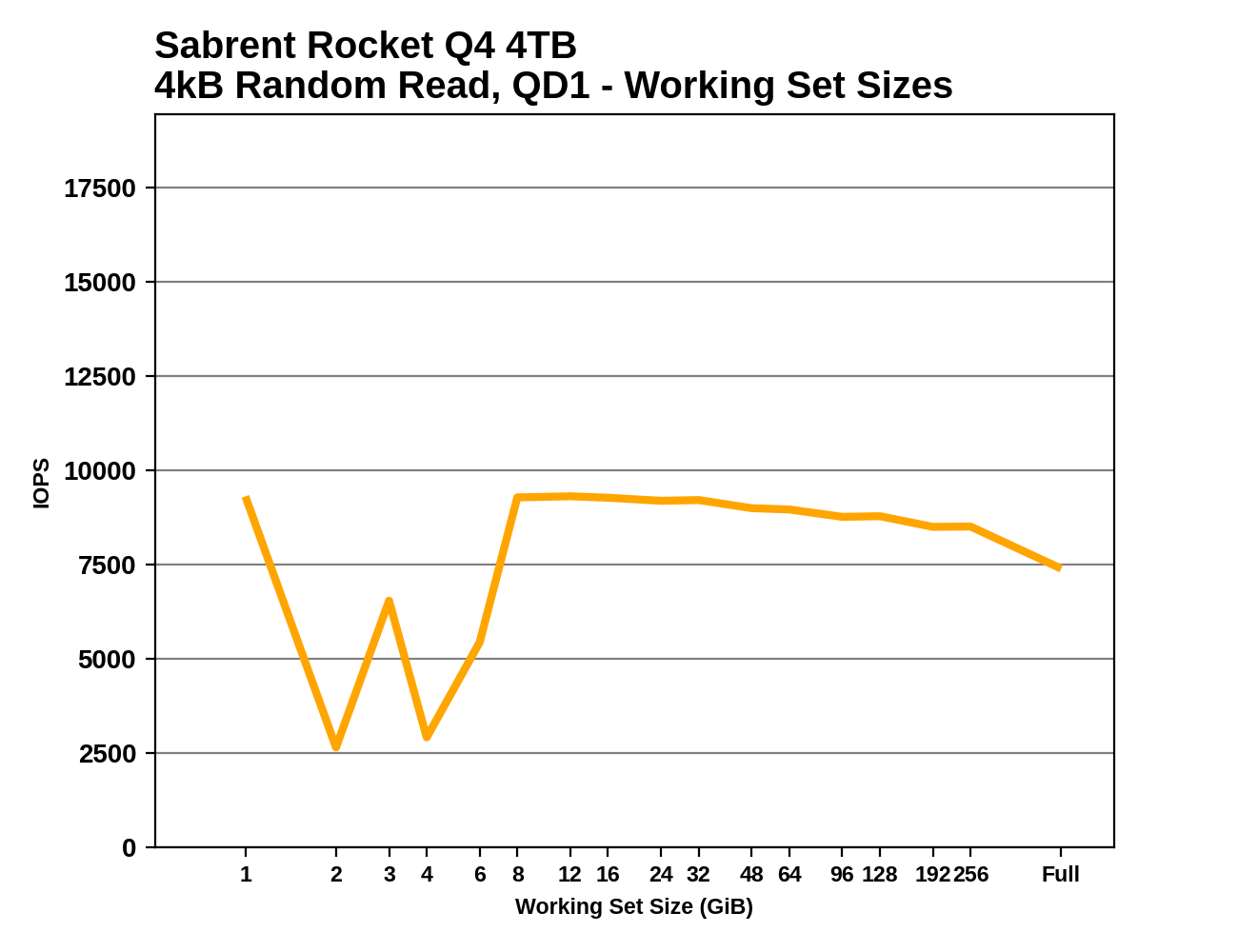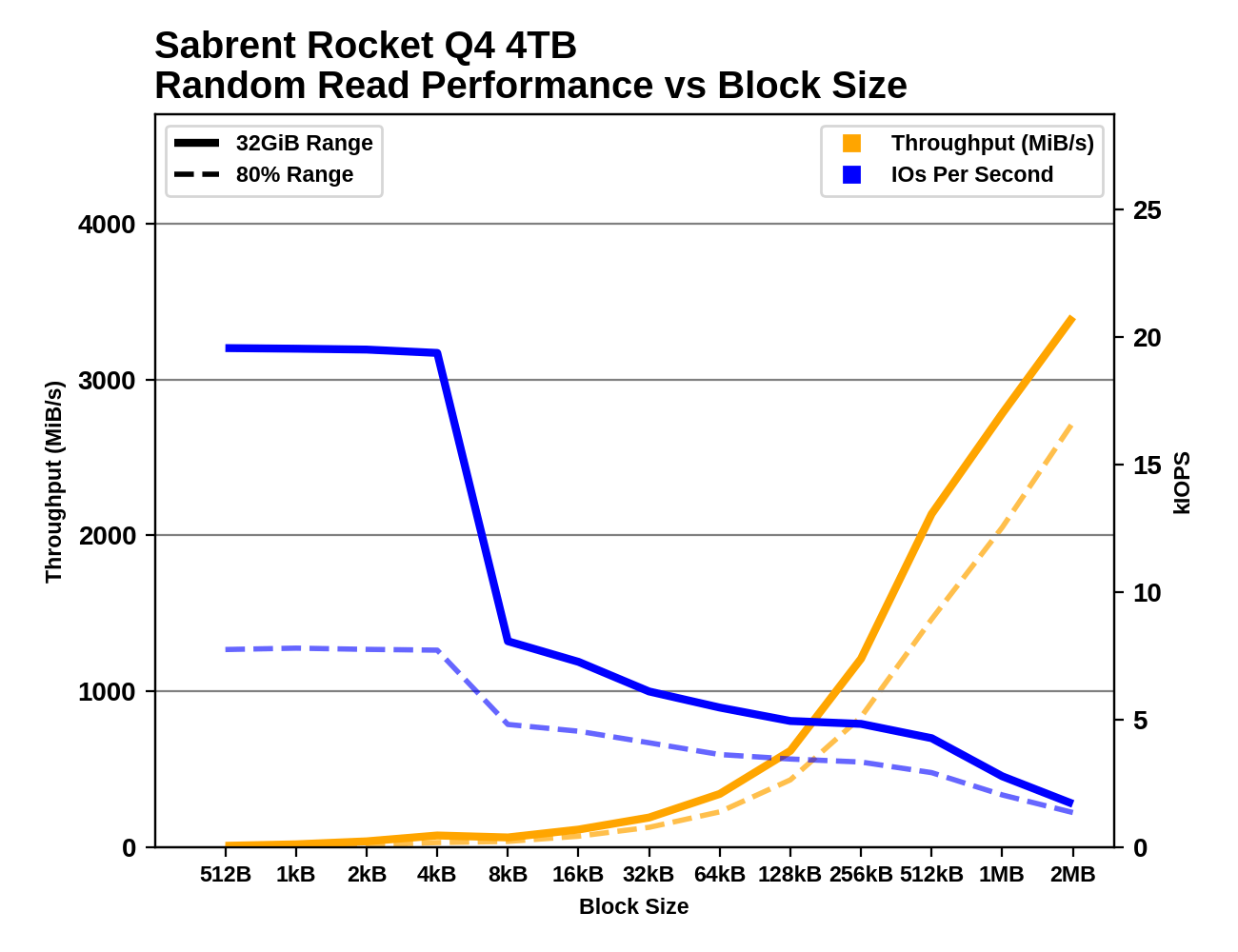Sabrent Rocket Q4 and Corsair MP600 CORE NVMe SSDs Reviewed: PCIe 4.0 with QLC
by Billy Tallis on April 9, 2021 12:45 PM ESTAdvanced Synthetic Tests
Our benchmark suite includes a variety of tests that are less about replicating any real-world IO patterns, and more about exposing the inner workings of a drive with narrowly-focused tests. Many of these tests will show exaggerated differences between drives, and for the most part that should not be taken as a sign that one drive will be drastically faster for real-world usage. These tests are about satisfying curiosity, and are not good measures of overall drive performance. For more details, please see the overview of our 2021 Consumer SSD Benchmark Suite.
Whole-Drive Fill
 |
|||||||||
| Pass 1 | |||||||||
| Pass 2 | |||||||||
As is typical for QLC drives based around Phison controllers, the SLC caches on the Rocket Q4 and MP600 CORE are as large as possible: about 1/4 the usable capacity of the drive. Write speeds to the cache hover around or just above the limit of what a PCIe 3 x4 link could handle, and once the cache is full performance drops down to well below the limit of what a SATA link could handle.
 |
|||||||||
| Average Throughput for last 16 GB | Overall Average Throughput | ||||||||
Both the 2TB MP600 CORE and the 4TB Rocket Q4 have about the same overall write speed, and they're in the middle of the pack of QLC drives: the older 8TB Rocket Q and the more recent Intel 670p both outperform the Phison E16 drives. And all of the TLC drives naturally sustain higher write speeds than any of these QLC drives.
Working Set Size
 |
|||||||||
Both the Rocket Q4 and MP600 CORE have some disappointing performance drops during the working set size test, suggesting there's background work keeping the drives busy despite all the idle time they get before the test and between phases of the test. But aside from that, we see the expected trends: the MP600 CORE has flat overall performance on account of having 2GB of DRAM for its 2TB of NAND, while the Rocket Q4 shows a slight performance decline for large working sets because it's managing 4TB of NAND with the same 2GB of DRAM.
Performance vs Block Size
 |
|||||||||
| Random Read | |||||||||
| Random Write | |||||||||
| Sequential Read | |||||||||
| Sequential Write | |||||||||
The two Phison E16 drives with QLC show similar patterns to the E12 QLC drives, but with substantial performance improvements in several places, most notable for random reads. These drives don't have any issues with block sizes smaller than 4kB, but there are performance drops at larger block sizes where the SLC cache runs out while testing random writes.










60 Comments
View All Comments
cyrusfox - Friday, April 9, 2021 - link
Great write up, unfortunate endurance regression (Went from 260 down to 225 cycles), seems only Intel is pushing QLC higher on endurance (200 to 300 to 370 cycles). Impressive random performance though, odd that only Intel appears to be extracting higher endurance with each new gen of QLC though.Samus - Sunday, April 11, 2021 - link
I noticed that in the 670p review and I'm glad someone pointed it out. I'd like to know if it's a programming\firmware logic thing that extracts better endurance through creative block wear leveling, reduced write amplification (perhaps delayed garbage collection and stuff) or they have more spare area? It's hard to believe they have superior manufacturing compared to "everyone" but maybe they do...Oxford Guy - Sunday, April 11, 2021 - link
Creativity isn't going to change the fact that there are twice as many voltage states in QLC vs. TLC.cyrusfox - Sunday, April 11, 2021 - link
With PLC on the horizon, QLC is going to look incredible by comparison :)I wonder what the internal goal is to make PLC viable, 70Cycles, 100 cycles? @ 32 Threshold charge states will be an engineering feat all on its own, Impressive QLC is able to function to nearly 400 cycles with 16 separate states(How much are they overprovisioned?).
From what I see in drive warranties based on underlying nand cells, we see around a 1/4 reduction in endurance/cycles each time they increase the bits per cell (10k,2k,400-1.2K,100-375,20-100). QLC is about 4 years old now with mass market release 3 years ago. PLC is definitely on the near horizon.
James5mith - Friday, April 9, 2021 - link
For the minimal price increase, get the E18 based Sabrent Rocket 4 Plus 4TB model. https://www.amazon.com/dp/B08VF99PV8/HideOut - Friday, April 9, 2021 - link
Thats still a big price increase. More than $150 even on sale.TheinsanegamerN - Saturday, April 10, 2021 - link
With far better long term write endurance, write speed, ece. QLC has a nasty habit of slowing WAY down once filled up.Oxford Guy - Sunday, April 11, 2021 - link
It shows its true performance.Once the 'SLC' disguise is gone...
wr3zzz - Friday, April 9, 2021 - link
I don't know why SN550 was used in the performance benchmarks when these QLC drives are priced at premium to SN750.sjkpublic@gmail.com - Friday, April 9, 2021 - link
For QLC write endurance I look at 600 x size. The numbers here are rather poor. Maybe its a mistake?